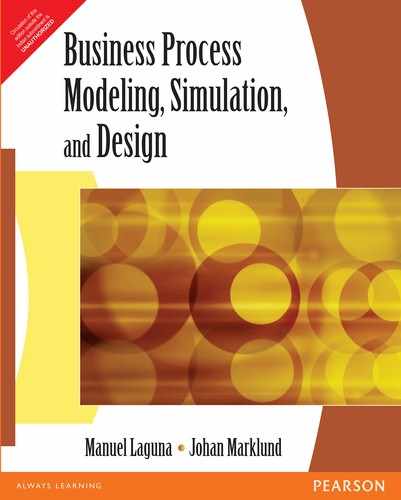Contents
chapter 1 Introduction to Business Process Design
1.1 What Is a Business Process?
1.1.1 Process Types and Hierarchies
1.1.2 Determinants of the Process Architecture
1.1.3 Workflow Management Systems
1.2 The Essence of Business Process Design
1.2.1 Incremental Process Improvement and Process Design
1.3 Business Process Design, Overall Business Performance, and Strategy
1.4 Why Do Inefficient and Ineffective Business Processes Exist?
1.7 Discussion Questions and Exercises
chapter 2 Process Management and Process-Oriented Improvement Programs
2.1 Process Management and the Power of Adopting a Process View
2.1.4 An Illustrative Example: Managing a Document Distribution Process
2.2 Six Sigma Quality Programs
2.2.2 The Six Sigma Cost and Revenue Rationale
2.2.3 Six Sigma in Product and Process Design
2.2.5 Concluding Remarks: Key Reasons for the Success of Six Sigma
2.3 Business Process Reengineering
2.3.1 Reengineering and Its Relationship with Other Earlier Programs
2.3.2 A Brief History of Reengineering
2.3.3 When Should a Process Be Reengineered?
2.3.4 What Should Be Reengineered?
2.3.5 Suggested Reengineering Frameworks
2.4 Revolutionary Versus Evolutionary Change
2.7 Discussion Questions and Exercises
chapter 3 A Simulation-Based Framework for Business Processes Design Projects
3.1 Step 1: Case for Action and Vision Statements
3.2 Step 2: Process Identification and Selection
3.3 Step 3: Obtaining Management Commitment
3.4 Step 4: Evaluation of Design Enablers
3.4.1 Example: The Internet-Enabling Change at Chase Manhattan Bank
3.4.2 Example: New Technology as a Change Enabler in the Grocery Industry
3.5 Step 5: Acquiring Process Understanding
3.5.1 Understanding the Existing Process
3.5.2 Understanding the Customer
3.6 Step 6: Creative Process Design
3.7 Step 7: Process Modeling and Simulation
3.8 Step 8: Implementation of the New Process Design
3.11 Discussion Questions and Exercises
chapter 4 Basic Tools for Process Design
4.2 Workflow Design Principles and Tools
4.2.1 Establish a Product Orientation in the Process
4.2.3 Establish One-at-a-Time Processing
4.2.4 Balance the Flow to the Bottleneck
4.2.5 Minimize Sequential Processing and Handoffs
4.2.6 Establish an Efficient System for Processing Work
4.2.7 Minimize Multiple Paths Through Operations
4.3 Additional Diagramming Tools
4.4 From Theory to Practice: Designing an Order-Picking Process
4.7 Discussion Questions and Exercises
chapter 5 Managing Process Flows
5.1 Business Processes and Flows
5.2 Cycle Time and Capacity Analysis
5.3 Managing Cycle Time and Capacity
5.3.2 Increasing Process Capacity
5.7 Discussion Questions and Exercises
chapter 6 Introduction to Queuing and Simulation
6.1 Queuing Systems, the Basic Queuing Process, and Queuing Strategies
6.1.1 The Basic Queuing Process
6.1.2 Strategies for Mitigating the Effects of Long Queues
6.2.1 The Exponential Distribution and Its Role in Queuing Theory
6.2.2 Terminology, Notation, and Little’s Law Revisited
6.2.3 Birth and Death Processes
6.2.8 Queuing Theory and Process Design
6.3 Introduction to Simulation
6.3.2 Discrete Event Simulation
6.3.3 Spreadsheet Simulation of a Single-Server Process
6.6 Discussion Questions and Exercises
chapter 7 Introduction to Extend
7.2 Extend Tutorial: Basic Queuing Model
7.3 Basic Data Collection and Statistical Analysis
7.4 Adding Randomness to Processing Times
7.5 Adding a Second Underwriting Team
7.8 Calculating Costs and Using the Flowchart View
7.11 Discussion Questions and Exercises
chapter 8 Modeling and Simulating Business Processes
8.2.2 Assigning Attributes to Items
8.10 Model Documentation and Enhancements
8.11 Process Design Case: Software Support
8.11.1 Modeling, Analysis, and Recommendations
8.12 Process Design Case: Hospital Admissions
8.15 Discussion Questions and Exercises
8.16 Modeling, Simulation, and Design Projects
chapter 9 Input and Output Data Analysis
9.2 Characterizing the Probability Distribution of Field Data
9.2.2 Using Stat::Fit to Fit a Distribution
9.2.3 Choosing a Distribution in the Absence of Sample Data
9.4 Generation of Random Variates
9.5 Analysis of Simulation Output Data
9.5.1 Nonterminating Processes
chapter 10 Optimizing Business Process Performance
10.1 Introduction to Optimization by Evolutionary Computation
10.3 Process Optimization Tutorial
10.4 Alternative Optimization Models
10.7 Process Modeling and Simulation Projects
10.7.1 Staffing a Process with Multiple Job Types
chapter 11 Process Benchmarking with Data Envelopment Analysis
11.1 Graphical Analysis of the Ratio Model
11.2 Linear Programming Formulation of the Ratio Model
11.3 Excel Add-in for Data Envelopment Analysis
